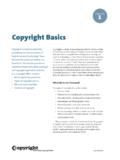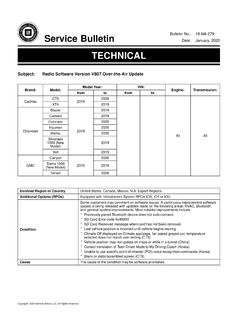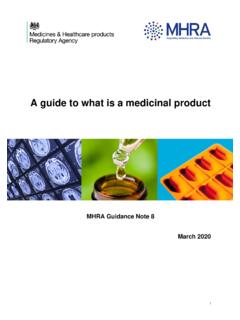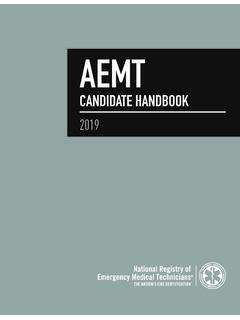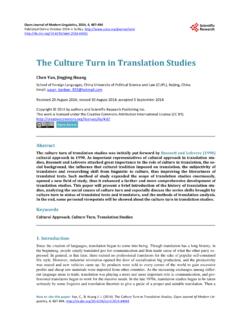Transcription of SOURCES, FATE AND EFFECTS OF MICROPLASTICS IN THE …
1 Science for Sustainable OceansISSN 1020 487390 REPORTS AND STUDIESREPORTS AND STUDIESSOURCES, FATE AND EFFECTS OF MICROPLASTICS IN THE MARINE ENVIRONMENT: A GLOBAL ASSESSMENTREPORTS AND STUDIES90 SOURCES, FATE AND EFFECTS OF MICROPLASTICS IN THE MARINE ENVIRONMENT: A GLOBAL ASSESSMENTP ublished by the INTERNATIONAL MARITIME ORGANIZATION 4 Albert Embankment, London SE1 7SR by Polestar Wheatons (UK) Ltd, Exeter, EX2 8 RPISSN: 1020-4873 Cover photo: Microplastic fragments from the western North Atlantic, collected using a towed plankton net. Copyright Giora Proskurowski, SEAN otes:GESAMP is an advisory body consisting of specialized experts nominated by the Sponsoring Agencies (IMO, FAO, UNESCO-IOC, UNIDO, WMO, IAEA, UN, UNEP, UNDP). Its principal task is to provide scientific advice concerning the prevention, reduction and control of the degradation of the marine environment to the Sponsoring report contains views expressed or endorsed by members of GESAMP who act in their individual capacities; their views may not necessarily correspond with those of the Sponsoring may be granted by any of the Sponsoring Agencies for the report to be wholly or partially reproduced in publication by any individual who is not a staff member of a Sponsoring Agency of GESAMP, provided that the source of the extract and the condition mentioned above are about GESAMP and its reports and studies can be found at: 1020-4873 (GESAMP Reports & Studies Series)Copyright IMO, FAO, UNESCO-IOC, UNIDO, WMO, IAEA, UN, UNEP, UNDP 2015 For bibliographic purposes this document should be cited as: GESAMP (2015).
2 Sources, fate and EFFECTS of MICROPLASTICS in the marine environment: a global assessment (Kershaw, P. J., ed.). (IMO/FAO/UNESCO-IOC/UNIDO/WMO/IAEA/UN/UN EP/UNDP Joint Group of Experts on the Scientific Aspects of Marine Environmental Protection). Rep. Stud. GESAMP No. 90, 96 editor: Peter KershawContributors to the report:Alison Anderson, Anthony Andrady, Courtney Arthur, Joel Baker, Henk Bouwman, Sarah Gall, Valeria Hidalgo-Ruz, Angela K hler, Kara Lavender Law, Heather Leslie, Peter Kershaw, Sabine Pahl, Jim Potemra, Peter Ryan, Won Joon Shim, Richard Thompson, Hideshige Takada, Alexander Turra, Dick Vethaak and Kayleigh REPORTS & STUDIES No. 90 MICROPLASTICS IN THE OCEAN 3 ContentsEXECUTIVE SUMMARY .. 5 ACKNOWLEDGMENTS.. 71 BACKGROUND TO GESAMP ASSESSMENT .. MICROPLASTICS in the ocean an emerging issue of international concern .. GESAMP response .. Scoping activities .. Working Group 40 .. 112 ASSESSMENT FRAMEWORK.
3 DPSIR Conceptual model .. Scope of assessment .. 123 SOURCES AND FATE OF MICROPLASTICS IN THE MARINE ENVIRONMENT .. Introduction .. Defining plastic .. Defining MICROPLASTICS .. Origin and types of plastic .. Primary and Secondary MICROPLASTICS .. Generation of MICROPLASTICS .. Weathering degradation of plastics in the ocean .. Fragmentation of plastics .. Biodegradation and Mineralization .. Sampling methods for MICROPLASTICS in the marine environment .. Introduction .. Sampling seawater .. Sampling sediments .. Sampling biota .. Determining the composition of MICROPLASTICS .. Distribution of MICROPLASTICS in the marine environment .. Influence of the source .. Distribution of MICROPLASTICS based on direct observations .. Transport pathways .. Modelling the transport and distribution of MICROPLASTICS .. Recommendations for further research.
4 294 EFFECTS OF MICROPLASTICS ON MARINE BIOTA .. Introduction .. Exposure .. Exposure through the gills .. Ingestion .. Uptake and transition into tissues, cells and organelles .. Excretion .. Transfer of MICROPLASTICS in the food web .. MICROPLASTICS as a vector of chemical transport into marine organisms .. Introduction .. 45 Page4 GESAMP REPORTS & STUDIES No. 90 MICROPLASTICS IN THE Contaminant transfer from m-size plastics to lower-trophic-level organisms .. Field evidence of contaminant transfer from mm-size plastics to higher-trophic-level organisms .. Biological impacts .. Physical EFFECTS .. Comparison with observed EFFECTS in mammalian systems .. Chemical EFFECTS .. Potential EFFECTS on populations, communities and ecosystems .. Potential EFFECTS on humans .. Recommendations for further research .. 535 SOCIAL ASPECTS OF MICROPLASTICS IN THE MARINE ENVIRONMENT .. Introduction.
5 Perceptions of marine litter and MICROPLASTICS .. Perceptions of marine litter in general .. Perceptions about MICROPLASTICS .. Public perceptions and coverage in the printed and digital media .. Perceived Risks .. Social and socio-economical impacts .. The role of individual, group and regional differences .. Overcoming barriers and towards solutions .. Education and Public Engagement .. Recommendations for further research .. 636 KEY OBSERVATIONS AND CONCLUSIONS .. Sources, distribution and fate of MICROPLASTICS .. EFFECTS .. Social aspects .. 657 KEY POLICY-RELATED RECOMMENDATIONS.. Rationale .. 657. 2 Action-orientated recommendations addressing marine MICROPLASTICS ..1 Challenge 1 .. Challenge 2 .. 3 Challenge 3 .. 677. 3 Recommendations to improve a future assessment .. 677. Challenge 4 .. 677. 3. 2 Challenge 5 .. Challenge 6 .. 68 REFERENCES .. 69 ANNEX I MEMBERSHIP OF THE WORKING GROUP.
6 92 ANNEX II LIST OF GESAMP REPORTS AND STUDIES .. 93 GESAMP REPORTS & STUDIES No. 90 MICROPLASTICS IN THE OCEAN 5 EXECUTIVE SUMMARYS ociety has used the ocean as a convenient place to dispose of unwanted materials and waste products for many centuries, either directly or indirectly via riv-ers. The volume of material increased with a growing population and an increasingly industrialized society. The demand for manufactured goods and packag-ing, to contain or protect food and goods, increased throughout the twentieth century. Large-scale produc-tion of plastics began in the 1950s and plastics have become widespread, used in a bewildering variety of applications. The many favourable properties of plas-tics, including durability and low cost, make plastics the obvious choice in many situations. Unfortunately, society has been slow to anticipate the need for dealing adequately with end-of-life plastics, to prevent plastics entering the marine environment.
7 As a result there has been a substantial volume of debris added to the ocean over the past 60 years, covering a very wide range of sizes (metres to nanometres in diameter). This is a phenomenon that has occurred wherever humans live or travel. As a result there are multiple routes of entry of plastics into the ocean, and ocean currents have transported plastics to the most remote regions. It is truly a global GESAMP assessment focuses on a category of plastic debris termed MICROPLASTICS . These small pieces of plastic may enter the ocean as such, or may result from the fragmentation of larger items through the influence of UV radiation. Section 1 provides an introduction to the problem of MICROPLASTICS in the marine environment, and the rationale for the assess-ment. The principal purpose of the assessment is to provide an improved evidence base, to support policy and management decisions on measures that might be adopted to reduce the input of MICROPLASTICS to the oceans.
8 The GESAMP assessment can be con-sidered as contributing to a more formal Assessment Framework, such as the Driver-Pressure-State-Impact-Response (DPSIR) Assessment Framework, which is introduced in Section nature of man-made polymers, different types and properties of common plastics and their behaviour in the marine environment are introduced in Section 3. There is no internationally agreed definition of the size below which a small piece of plastic should be called a microplastic. Many researchers have used a definition of <5 mm, but this encompasses a very wide range of sizes, down to nano-scales. Some MICROPLASTICS are purposefully made to carry out certain functions, such as abrasives in personal care products ( toothpaste and skin cleaners) or for industrial purposes such as shot-blasting surfaces. These are often termed pri-mary MICROPLASTICS . There is an additional category of primary particle known as a pellet.
9 These are usually spherical or cylindrical, approximately 5 mm in diam-eter, and represent the common form in which newly produced plastic is transported between plastic pro-ducers and industries which convert the simple pellet into a myriad of different types of potential physical and chemical impacts of micro-plastics, and associated contaminants, are discussed in detail in Section 4. The physical impacts of larger litter items, such as plastic bags and fishing nets, have been demonstrated, but it is much more dif-ficult to attribute physical impacts of MICROPLASTICS from field observations. For this reason researchers have used laboratory-based experimental facilities to investigate particle uptake, retention and EFFECTS . Chemical EFFECTS are even more difficult to quantify. This is partly because seawater, sediment particles and biota are already contaminated by many of the chemi-cal substances also associated with plastics.
10 Organic contaminants that accumulate in fat (lipids) in marine organisms are absorbed by plastics to a similar extent. Thus the presence of a contaminant in plastic frag-ments in the gut of an animal and the measurement of the same contaminant in tissue samples does not imply a causal relationship. The contaminant may be there due to the normal diet. In a very small number of cases, contaminants present in high concentrations in plastic fragments with a distinctive chemical signature (a type of flame retardant) can be separated from related con-taminants present in prey items and have been shown to transfer across the gut. What is still unknown is the extent to which this might have an ecotoxicological impact on the is recognized that people s attitudes and behav-iour contribute significantly to many routes of entry of plastics into the ocean. Any solutions to reducing these sources must take account of this social dimen-sion, as attempts to impose regulation without public understanding and approval are unlikely to be effective.











